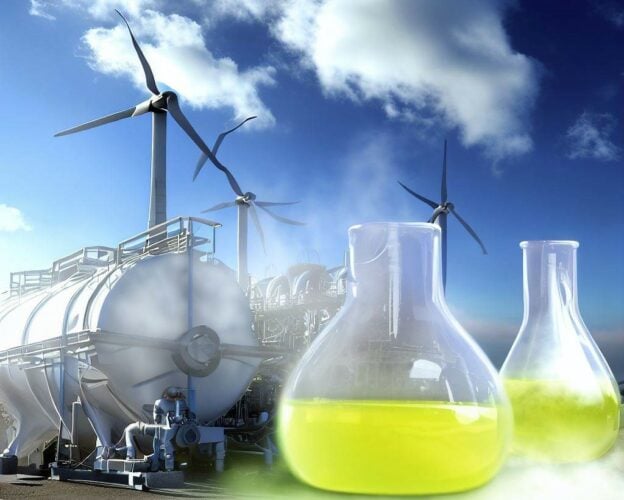Introduction
Climate change and sustainability are aspects that today are in the focus of the entire society that is concerned about decarbonization. In the search for clean and renewable alternatives, ammonia as an energy source is emerging as one of the most promising to promote a more sustainable future.
The potential of ammonia as a alternative to fossil fuels It’s very important; get involved in different industrial sectors as a promising alternative energy. Its benefits are very outstanding, therefore, its contribution to a more sustainable future is relevant.
To achieve a successful energy transition, it is essential to explore all possibilities and alternatives. The current results clearly indicate that the ambitious global goals of carbon neutrality cannot be achieved without considering and testing all available resources.
Ammonia as an energy source
This chemical compound, identified by the formula NH3, has been widely used in the agricultural and chemical industries, however, it has recently attracted considerable interest as a renewable energy source. This compound, made up of nitrogen and hydrogen, has great potential as a valuable energy vector.
When the NH3 It is produced using clean energy sources, such as wind, solar, bioenergy, among others, instead of using fossil hydrocarbons, it is called green ammonia, because it is produced through the process called electrolysis where renewable electricity is used to divide the molecules of water in its basic components, hydrogen and oxygen; then, the hydrogen obtained is combined with nitrogen to form ammonia.
Green ammonia, as a source of energy in the energy transition
During the production of green ammonia, direct greenhouse gas emissions are almost zero. This makes it a clean and sustainable energy source, as it does not contribute to climate change or deplete fossil resources. Its main advantage as a source of energy comes mainly from the properties that facilitate its storage and transport, which makes it a viable option for distribution and general use.
When this chemical compound is used for fuel or to generate electricity, it is converted back into hydrogen and nitrogen gas, releasing only water and nitrogen as by-products, making it a carbon-free method of storing and transporting energy.

The main potential for ammonia energy is that it can be produced using nothing more than air, water and green energy. Its main advantage as a fuel is that it does not contain carbon and, therefore, CO2 is not formed during its combustion in engines.
Ammonia has a high energy content, when compressed into a liquid form, it contains up to three times more energy per volume than natural gas. This makes it an alternative to fossil fuels in various applications, such as transportation in all its versions and electricity generation.
In the transport sector, NH3 can be used in fuel cells, allowing the generation of electricity with minimal carbon emissions. In addition, its energy density makes it easy to store and transport, which could revolutionize the shipping and heavy road transport industry, significantly reducing polluting gas emissions.
Contribution of ammonia to global sustainability
NH3 as a clean energy source has the potential to contribute to sustainability on a large scale. First, it can be produced by renewable energy sources allowing for a totally clean power cycle, where green ammonia comes from, which is among several key synthetic fuels to establish a greener industry in the near future.
This chemical compound shows the possibility of being used in industries that are difficult to decarbonize, as an alternative to traditional fuels, which would result in a substantial reduction in carbon emissions from different industrial processes and thus contribute to the reduction of emissions in line with the global objectives of environmental sustainability.
It also works as an energy carrier in a similar way to hydrogen, its main competitor. However, it presents characteristics that make it even more promising than hydrogen in the context of the energy transition. Despite this, the production costs of green ammonia remain an obstacle to widespread adoption.
Technological developments of ammonia
The development of technologies to produce, store, distribute, and use NH3 as an alternative energy source has experienced specific advances recently. Researchers have worked on improving the synthesis of ammonia from sustainable nitrogen sources, such as air and water, thus reducing the industry’s reliance on nitrogen obtained from highly energetic processes.
Efforts have been made to improve the efficiency of fuel cells using ammonia, increasing power density and reducing production costs. Storage and transport systems have also been the subject of research and development, seeking safe and efficient solutions for large-scale use.
Companies plan and continue to work to improve ammonia conversion technologies for mostly heavy-duty and large engines such as trucks, tractors and ships. This alternative of fuels from hydrocarbons; it also has in mind the mobilization of private vehicles in the coming years.
Here are some of the most notable developments:
MAN Energy Solutions: Has marked an important milestone on the way to the development of large-scale two-stroke marine engines. The first combustion test of an ammonia-fueled marine engine was successfully carried out at the facilities of its research center in Copenhagen. The results obtained were positive in terms of the amount of pilot oil and the stability of the combustion.
They emphasize that there is still much to be investigated, they will continue with the tests to study the release of heat, ignition, safety, the fraction of energy for the pilot flame, and gas emissions. The company plans to get a full-scale test engine running on ammonia in late 2023 or early 2024. They plan to deliver the first powered engine from 2026, which has generated high interest and numerous inquiries for large merchant ships.
This company has positive expectations regarding NH3 as an energy source, due to its lower expected production cost compared to other relevant electronic fuels; They predict that by 2050, approximately 27% of the fuel used on board large merchant marine vessels will be ammonia.

A green ammonia engine for passenger cars: Guangzhou Automobile Group Corp (GAC) and Toyota have unveiled a prototype engine powered by liquid ammonia, a fuel that could be an alternative energy source to electricity and hydrogen. The new internal combustion engine draws inspiration from the freight and shipping sectors. The engine is a 2.0-liter 4-cylinder, produces 161 hp, and reduces carbon emissions by 90% compared to conventional gasoline engines.
Although it is not the first internal combustion engine developed to run on NH3, it is the first to be proposed for possible use in passenger cars. GAC claims that they have overcome the problems of ammonia combustion, including excess nitrogen emissions, thanks to an increase in combustion pressure compared to conventional gasoline engines.
Iberdrola: This world leading company in renewable energy, in alliance with Trammo, the world’s largest maritime marketer and distributor of anhydrous ammonia, have signed the largest green ammonia agreement in Europe, they will build the first plant in the south of this continent, which will allow the export of up to 100,000 tons per year, starting in 2026.
The plant will be linked to the construction of 500 MW of new renewable energy, the green ammonia will meet all the requirements demanded by Europe. The green ammonia production will be bought and sold by Trammo to supply competitive green energy to decarbonize energy-intensive heavy industry across the continent, such as the Netherlands, Germany or France.
In addition, there are other projects where ammonia is the protagonist of large investments. To mention, soon South Africa could have a mega green ammonia plant, the company Coega Development Corporation plans to build the largest green ammonia plant in the world in the Eastern Cape of South Africa, this fuel of the future will be used mainly in the marine industry.
Conclusions
Green ammonia is an energy vector with great potential that can significantly contribute to the application of sustainable energy to multiple activities and promote progress towards the decarbonization of the economy. Its high energy density, ease of storage and transportation, as well as its ability to be produced from renewable sources, make it an alternative product to replace fossil fuels and reduce carbon emissions in the future.
This type of fuel may be a viable, low-carbon energy source for the future. It has properties that make it a great choice for various use cases. However, the vast majority of ammonia comes from fossil fuels, and green ammonia is still a nascent industry.
As technology continues to advance in the production of alternative energy and costs decrease, its use will be important in the transition towards a more sustainable and carbon-free future and will contribute to the fight against climate change and the preservation of the planet.
References
Own source

